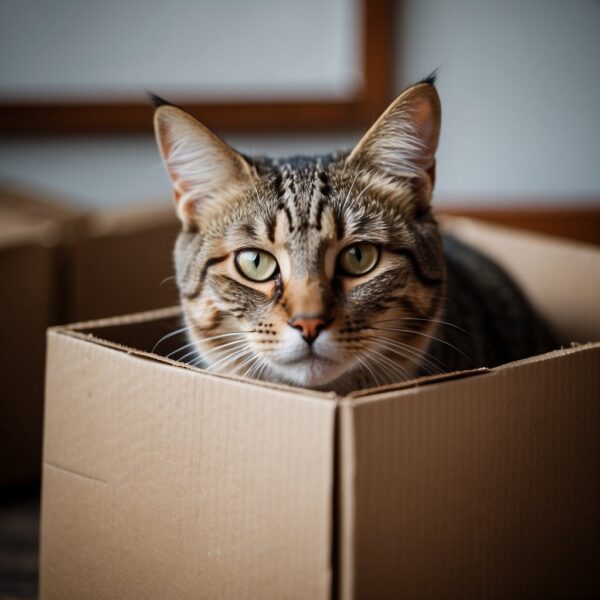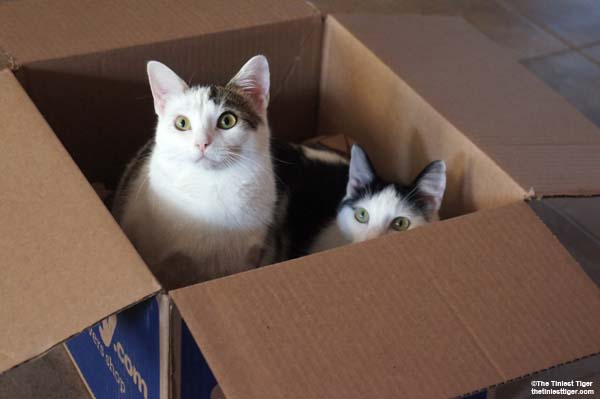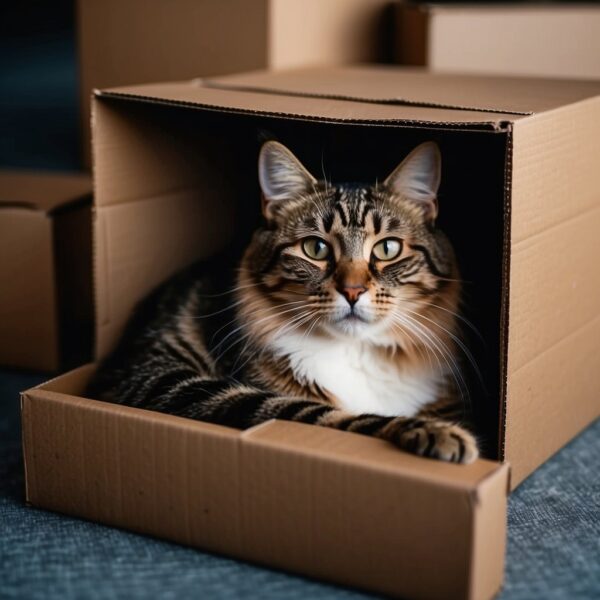
Why Cats Like Boxes: Exploring the Feline Fascination
Understanding why cats are drawn to boxes can help cat parents provide environments that enhance their cat’s mental and physical well-being. The appeal of cardboard boxes lies in their provision of a confined space where a cat can feel insulated from stress and external threats. This can be particularly beneficial to a newly adopted cat adapting to its environment or in a stressful situation. Furthermore, the texture and smell of the cardboard itself provide sensory stimulation, and the act of chewing or scratching offers a form of stress relief. For indoor cats, boxes also add a layer of complexity to their environment, allowing for exploration and play that mimics their natural behaviors in the wild.
Cats have a notorious affinity for cardboard boxes that often baffles their human companions. This box obsession isn’t just a whimsical quirk – it’s deeply rooted in feline instinct and behavior. The allure of cardboard for cats is multifaceted, involving their need for security, the intriguing sensory experience cardboard provides, and the box’s utility as an object of play. Essentially, the humble cardboard box caters to various aspects of a cat’s life, from offering a secluded retreat where they can observe the world safely, to serving as an impromptu toy that satisfies their natural hunting instincts.
Key Takeaways
- Cats’ attraction to cardboard boxes is connected to biological behaviors and a need for security.
- Cardboard offers sensory stimulation and a venue for play that can contribute to a cat’s well-being.
- Understanding this behavior can assist owners in creating a stress-reducing and enriching environment for their cats.

The Fascination Behind Cats and Cardboard
Cats exhibit a remarkable affection for cardboard boxes, with their behavior reflecting a desire for comfort and a need for security.
Understanding Cat Behavior
Cats love boxes as these simple items provide them with multiple benefits that cater to their instinctual needs. It is not just an affinity; there are tangible reasons for this behavior. Cardboard offers both insulation and a snug environment, making it an ideal retreat for rest and relaxation. The confined space of a box can offer a sense of security, shielding cats from potential threats and allowing them to observe their surroundings without being seen.
Cats also appreciate the texture of cardboard. The material provides an enticing surface that’s suitable for scratching — a natural behavior for feline claw maintenance. More than merely a pastime, interacting with boxes fulfills a cat’s natural instincts to explore confined spaces, which in the wild could provide a safe spot from predators as well as an opportunistic spot from which to ambush prey.
Additionally, cardboard has an insulating effect, which can help keep cats warm. The comfort derived from this insulation is especially appreciated by cats, who have a propensity to seek out warm locations for their naps.
Behaviorally, a cardboard box can serve as a personal space where a cat can retreat and manage stress. It adds an element of predictability and control over their environment, two factors highly valued by felines. As a result, a simple cardboard box can sometimes be one of the most effective and least expensive ways to enrich a cat’s living environment, promoting well-being and reducing potential stress-related behaviors.

Safety, Stress, and Shelter
The fascination cats have with boxes is closely tied to their need for safety, stress relief, and shelter. Through an understanding of feline instincts, the benefits of cardboard retreats for both house and shelter cats become clear.
Predators and Prey Dynamics
In the animal kingdom, it’s imperative for predators and prey to utilize their environment for survival. Cats, despite being domesticated, still harbor the evolutionary behaviors of their wild ancestors. Enclosed spaces such as boxes replicate the secluded areas cats would seek out in the wild to hide from predators, as well as to stealthily stalk their prey. This instinctive behavior enhances cats’ sense of safety, turning commonplace cardboard into a strategic refuge.
The Role of Boxes in Stress Reduction
For house cats, the common box provides a secluded space where they can escape and decompress, significantly reducing their stress levels. The box acts as a personal haven where cats can observe their surroundings without the fear of being caught off-guard. Notable insights include:
- Boxes reduce visual stimulation and shelter from household commotion, creating a calming environment.
- Cats often retreat to a box during stressful situations, such as the arrival of a new pet or family member.
Shelter and Security for Shelter Cats
Shelter cats, often in the process of acclimating to a new and potentially stressful environment, benefit greatly from the presence of a box. By providing a boxed hiding spot, shelters can help improve the well-being of their feline residents. This approach serves two purposes:
- Boosting Confidence: A box can become a place of empowerment, helping a shy or fearful cat build confidence over time.
- Aiding in Transition: For newly adopted cats, a box in their new home serves as a continuity of their shelter environment, helping them adjust to their surroundings more efficiently.
Cats like Boxes as a Source of Entertainment
Cardboard boxes are not merely a place for cats to rest; they are a staging ground for cats to engage in play and exercise their hunting instincts, all while satisfying their inquisitive nature through exploration.
Play and Hunting Instincts
Cats often treat boxes as toys, demonstrating a playful attitude that taps into their innate hunting instincts. They may simulate stalking, attacking, and capturing prey as they pounce in and out of boxes. This playful behavior is part of a healthy lifestyle, keeping them engaged and physically active. The confined space of a box provides an ideal ambush site, which in the wild would be used to launch surprise attacks on unsuspecting prey. As domesticated animals, their fascination with boxes is a reflection of these deep-rooted instincts, now repurposed for fun rather than survival.
- Stalking: They silently watch their surroundings from the security of the box.
- Chasing: Pouncing on toys or other objects that come close to their hideout.
- Capturing: Grabbing toys or household items inside or around the box with quick, precise movements.
Inquisitive Nature and Exploration
The same curiosity that drives cats to explore new spaces in their environment leads them to investigate every corner of a cardboard box. To a cat, a box represents a puzzle to be solved, a territory to be mapped out, and a new scene for their exploratory missions. They enjoy the sensory experience of scratching and biting the cardboard, and the noise it makes can be intriguing.
- Discovery: Each box is a new world to discover, with its unique smell and texture.
- Sensory Stimulation: The feel of the cardboard beneath their paws and the sound it makes contribute to their entertainment.
By providing cats with a simple cardboard box, parents are catering to their cat’s desire for fun and enabling their natural behaviors in a safe and controlled environment.

cats like boxes for Sensory Appeal of Cardboard
Cardboard boxes provide a unique environment appealing to cats both physically and through sensory stimulation.
Texture and Insulation
Texture plays a pivotal role in a cat’s attraction to cardboard. The surface of a cardboard box is ideal for scratching, allowing cats to maintain their claws and engage in a natural marking behavior. The cardboard’s texture offers an excellent outlet for biting and shredding, activities that cater to a cat’s hunting instincts. Additionally, cardboard boxes offer superior insulation, creating a warm and cozy refuge. This insulation factor not only preserves body heat but also provides a snug and protective shelter that cats instinctively seek out.
- Warmth Retention: Cardboard insulates heat effectively, providing a warm space.
- Scratch-friendly: The coarse texture is perfect for claw maintenance.
Scent Marking and Catnip Interaction
Cardboard boxes also serve as a canvas for scent marking. Cats possess scent glands in their cheeks and paws, which they use to mark territory as safe and familiar. Rubbing against and scratching the cardboard allows a cat to deposit its scent, which is a comforting behavior that reinforces the cat’s sense of security. Moreover, cardboard can enhance a cat’s interaction with catnip, as its porous nature absorbs the catnip’s scent, eliciting a strong and prolonged response from the cat.
- Scent Absorption: Cardboard’s porous nature holds scents well, making it an excellent medium for scent marking.
- Catnip Retention: Cardboard holds onto catnip, increasing attraction and interaction.
Health and Well-being Contributions
Cardboard boxes contribute significantly to a cat’s health and well-being by addressing their innate needs for rest and a sense of ownership. These simple structures provide a sanctuary for stress relief and foster natural feline behaviors that are essential for their mental and physical health.
Sleeping and Resting Habits
Cats spend a large portion of their day sleeping, and cardboard boxes offer an ideal bed for resting. Enclosed spaces help cats feel secure and protected from potential threats, which enhances the quality of their sleep. The confined nature of a box also retains pheromones, creating a familiar and comforting environment.
- Benefits of boxes for sleep and rest:
- Enhanced feeling of security during sleep
- Retention of cat’s own pheromones, amplifying comfort and familiarity
Nesting and Ownership
Boxes act as an extension of a cat’s nesting behavior. They provide a space for a cat to claim as their own, reinforcing their territorial instincts. Feeling a sense of ownership over a safe, enclosed area can significantly reduce stress levels.
- Importance of boxes for nesting and ownership:
- Aiding in establishing a zone of comfort and control
- Offering a stress-free refuge where they can retreat and relax
Practical Considerations for cat Parents
Cat parents seeking to enrich their cats’ environment often turn to cardboard boxes for their versatility and safety. These boxes can serve as cost-effective carriers and entertainment tools while also considering the recycling aspects and health concerns related to pica in cats.
Cardboard Boxes as Cat Carriers
Utility: Cardboard boxes can be effectively repurposed as temporary cat carriers. For short distances, they provide a familiar and comforting space for felines. Ensure the box is secure by checking that flaps are intact and strong enough to contain the cat, and reinforce them with tape if necessary.
Ventilation: It’s crucial to make sufficient air holes for ventilation. Without proper airflow, the box could become an unsafe environment very quickly.
Recycling Cards and Pica
Sustainable Practices: Boxes serve multiple functions, from play object to bed, and can be part of a responsible recycling practice. Cat parents may recycle these carriers or toys once worn out, but it’s important to remove any tape or labels that can’t be recycled.
Health Precautions: Pica is a condition where cats eat inedible objects and can be exacerbated by boredom or anxiety. Monitor your cat’s interaction with cardboard to prevent ingestion, which can lead to intestinal obstructions. If pica behavior is observed, remove cardboard access and consult a veterinarian.
Frequently Asked Questions
In exploring the affinity cats have for cardboard boxes, several common queries arise. This section addresses those inquiries with clear, evidence-based insights.
What attracts cats to cardboard boxes as resting places?
Cats are instinctively attracted to cardboard boxes because they offer a secure, enclosed space. This simulates the safe dens they seek in the wild, providing an ideal spot for rest and observation.
Is there a reason cats prefer smaller boxes, even if they appear too constricted?
Smaller boxes may be preferred because the snug fit offers additional warmth and comfort. This tight space can also enhance their sense of security, as it reduces the area that needs to be monitored for potential threats.
How do boxes and other confined spaces benefit a cat’s well-being?
Boxes and confined spaces can significantly benefit a cat’s well-being by reducing stress. They serve as a retreat where cats can escape from the hustle of a busy household and have some alone time, which is crucial for their mental health.
What is it about cardboard that cats are often drawn to chewing on?
Cats may chew on cardboard due to its texture, which can be satisfying for their teeth and gums. Additionally, the act of chewing can be a form of play or a way to relieve anxiety.
Can the scent of cardboard impact a cat’s liking for boxes?
While the scent of cardboard is not typically a primary factor in a cat’s interest, some cats may be attracted to it due to individual preferences or the smell of certain adhesives used in the box’s production.
Why might a cat choose a box over its own bed for sleeping?
Cats may choose a box over their bed for its insulating properties, as cardboard can retain heat. A box’s structure also allows cats to feel more concealed and secure, which may not be the case with open, exposed beds.